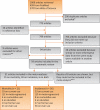A systematic review and meta-analysis of tobacco use and prostate cancer mortality and incidence in prospective cohort studies
- PMID: 25242554
- PMCID: PMC4566150
- DOI: 10.1016/j.eururo.2014.08.059
A systematic review and meta-analysis of tobacco use and prostate cancer mortality and incidence in prospective cohort studies
Abstract
Context: An association between tobacco smoking and prostate cancer (PCa) incidence and mortality was suggested in an earlier meta-analysis of 24 prospective studies in which dose-response associations and risks per unit of tobacco use were not examined.
Objective: We investigated the association between several measures of tobacco use and PCa mortality (primary outcome) and incidence (secondary outcome) including dose-response association.
Evidence acquisition: Relevant articles from prospective studies were identified by searching the PubMed and Web of Science databases (through January 21, 2014) and reference lists of relevant articles. Combined relative risks (RRs) and 95% confidence intervals (CIs) were calculated using random effects methods. We also calculated population attributable risk (PAR) for smoking and PCa mortality.
Evidence synthesis: We included 51 articles in this meta-analysis (11823 PCa deaths, 50349 incident cases, and 4,082,606 cohort participants). Current cigarette smoking was associated with an increased risk of PCa death (RR: 1.24; 95% CI, 1.18-1.31), with little evidence for heterogeneity and publication bias. The number of cigarettes smoked per day had a dose-response association with PCa mortality (p=0.02; RR for 20 cigarettes per day: 1.20). The PAR for cigarette smoking and PCa deaths in the United States and Europe were 6.7% and 9.5%, respectively, corresponding to >10000 deaths/year in these two regions. Current cigarette smoking was inversely associated with incident PCa (RR: 0.90; 95% CI, 0.85-0.96), with high heterogeneity in the results. However, in studies completed in 1995 or earlier (considered as completed before the prostate-specific antigen screening era), ever smoking showed a positive association with incident PCa (RR: 1.06; 95% CI, 1.00-1.12) with little heterogeneity.
Conclusions: Combined evidence from observational studies shows a modest but statistically significant association between cigarette smoking and fatal PCa. Smoking appears to be a modifiable risk factor for PCa death.
Patient summary: Smoking increases the chance of prostate cancer death. Not smoking prevents this harm and many other tobacco-related diseases.
Keywords: Cigarettes; Meta-analysis; Prospective; Prostate cancer; Smoking.
Copyright © 2014 European Association of Urology. Published by Elsevier B.V. All rights reserved.
Figures



Comment in
-
Re: Farhad Islami, Daniel M. Moreira, Paolo Boffetta, Stephen J. Freedland. A Systematic Review and Meta-analysis of Tobacco Use and Prostate Cancer Mortality and Incidence in Prospective Cohort Studies. Eur Urol 2014;66:1054-64.Eur Urol. 2015 Jul;68(1):e13. doi: 10.1016/j.eururo.2015.01.023. Epub 2015 Feb 7. Eur Urol. 2015. PMID: 25666849 No abstract available.
Similar articles
-
Heated tobacco products for smoking cessation and reducing smoking prevalence.Cochrane Database Syst Rev. 2022 Jan 6;1(1):CD013790. doi: 10.1002/14651858.CD013790.pub2. Cochrane Database Syst Rev. 2022. PMID: 34988969 Free PMC article.
-
Electronic cigarettes for smoking cessation.Cochrane Database Syst Rev. 2022 Nov 17;11(11):CD010216. doi: 10.1002/14651858.CD010216.pub7. Cochrane Database Syst Rev. 2022. Update in: Cochrane Database Syst Rev. 2024 Jan 8;1:CD010216. doi: 10.1002/14651858.CD010216.pub8. PMID: 36384212 Free PMC article. Updated.
-
Electronic cigarettes for smoking cessation.Cochrane Database Syst Rev. 2021 Sep 14;9(9):CD010216. doi: 10.1002/14651858.CD010216.pub6. Cochrane Database Syst Rev. 2021. Update in: Cochrane Database Syst Rev. 2022 Nov 17;11:CD010216. doi: 10.1002/14651858.CD010216.pub7. PMID: 34519354 Free PMC article. Updated.
-
Selenium for preventing cancer.Cochrane Database Syst Rev. 2018 Jan 29;1(1):CD005195. doi: 10.1002/14651858.CD005195.pub4. Cochrane Database Syst Rev. 2018. PMID: 29376219 Free PMC article.
-
Electronic cigarettes for smoking cessation.Cochrane Database Syst Rev. 2025 Jan 29;1(1):CD010216. doi: 10.1002/14651858.CD010216.pub9. Cochrane Database Syst Rev. 2025. PMID: 39878158 Free PMC article.
Cited by
-
Prostate tumor DNA methylation is associated with cigarette smoking and adverse prostate cancer outcomes.Cancer. 2016 Jul 15;122(14):2168-77. doi: 10.1002/cncr.30045. Epub 2016 May 3. Cancer. 2016. PMID: 27142338 Free PMC article.
-
Tobacco smoking and death from prostate cancer in US veterans.Prostate Cancer Prostatic Dis. 2020 Jun;23(2):252-259. doi: 10.1038/s41391-019-0178-6. Epub 2019 Oct 17. Prostate Cancer Prostatic Dis. 2020. PMID: 31624316
-
Influence of lifestyle choices on risks of CYP1B1 polymorphisms for prostate cancer.J Cell Mol Med. 2018 Oct;22(10):4676-4687. doi: 10.1111/jcmm.13696. Epub 2018 Aug 22. J Cell Mol Med. 2018. PMID: 30133114 Free PMC article.
-
Prostate cancer and glutathione S-transferase deletions.EXCLI J. 2015 Sep 21;14:1049-54. doi: 10.17179/excli2015-192. eCollection 2015. EXCLI J. 2015. PMID: 26600754 Free PMC article.
-
Prostate cancer-specific death in brachytherapy treated high-risk patients stratified by pre-treatment PSA.J Contemp Brachytherapy. 2017 Aug;9(4):297-303. doi: 10.5114/jcb.2017.69588. Epub 2017 Aug 30. J Contemp Brachytherapy. 2017. PMID: 28951747 Free PMC article.
References
-
- Jemal A, Bray F, Center MM, Ferlay J, Ward E, Forman D. Global cancer statistics. CA Cancer J Clin. 2011;61:69–90. - PubMed
-
- Rota M, Scotti L, Turati F, et al. Alcohol consumption and prostate cancer risk: a meta-analysis of the dose-risk relation. Eur J Cancer Prev. 2012;21:350–9. - PubMed
-
- Discacciati A, Orsini N, Wolk A. Body mass index and incidence of localized and advanced prostate cancer–a dose-response meta-analysis of prospective studies. Ann Oncol. 2012;23:1665–71. - PubMed
Publication types
MeSH terms
Grants and funding
LinkOut - more resources
Full Text Sources
Other Literature Sources
Medical

